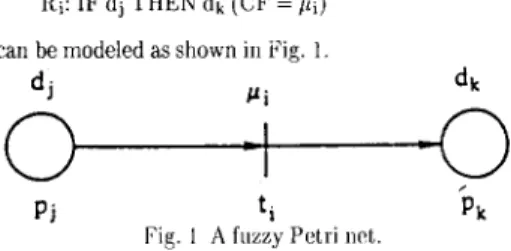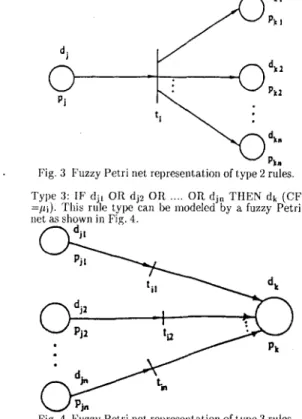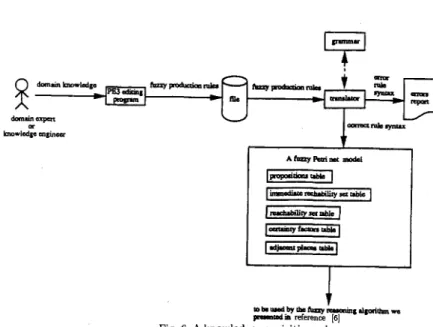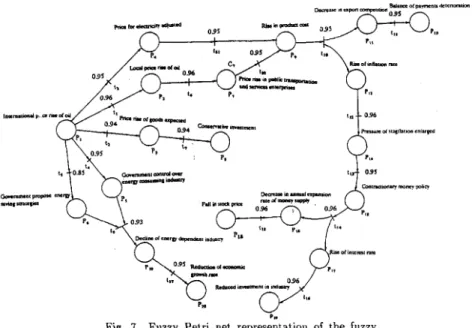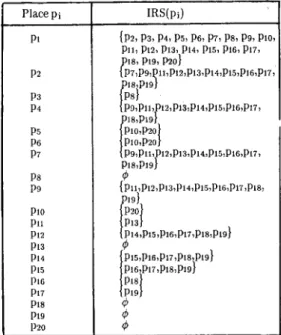IEEE TENCON '93 / BeiJng
A KNOWLEDGE ACQUISITION SCHEME FOR RULE-BASED SYSTEMS
Shyi-Ming Chen
Department of Computer and Information Science National Chiao Tung University,
Hsinchu, Taiwan, China
ABSTRACT
In this paper, we present a knowledge acquisition scheme for rulebased systems, where the domain expert or the knowledge engineer can express the domain knowledge in the form of fuzzy production rules and create a file containing these rules on a PC/AT by usin the P E 3 editing program. Then, a translator is devioped t o translate the file of fuzzy production rules into a fuzzy Petri net model (FPN). Furthermore, the domain expert or the knowledge engineer can add new knowledge or update the existing knowledge by inserting new rules into the file or by updating the rules in the file using the P E 3 editing program.
INTRODUCTION
Knowledge acquisition is one of the research topics of expert systems1 2 , 3 , 4 9 5. Lunger and Stubblefields pointed out that many expert systems include a knowledge base editor which may assist in the addition of new knowledge and help maintaining the correct rule syntax. In 1990, we have presented a fuzzy Petri net model (FPN 6 for knowledge representation, and fuzzy Petri net model, where the fuzzy Petri net model is used to represent the fuzzy production rules6,7,8,9 of a rulebased system. However, in reference [ 6 ] , we assumed that the the number of fuzzy production rules in the knowledge base is fixed. If we can allow the domain expert or the knowledge engineer to add new fuzzy production rules into the knowledge base and update the fuzzy production rules existing in' the knowledge base, then there is room for more flexibility.
In this paper, we present a knowledge acquisition scheme for rule-based systems, where the domain expert or the knowledge engineer can express the domain knowledge in the form of fuzzy production rules and create a file containing these rules on a PC/AT by using the P E 3 editing programlo. Then, a translator is developed t o translate the file into a fuzzy Petri net model (FPN) which can be used by the fuzzy rea,soning algorithm presented in reference [6]. Furthermore, the domain expert or the knowledge engineer can add new knowledge or update the existing knowledge by inserting new rules into the file or by updating the rules in the file using the P E 3 editing program.
developed a
t'
uzzy reasoiling algorithm based on theKNOWLEDGE REPRESENTATION
In the following, we briefly review the concepts of fuzzy production rules. Let R be a set of fuzzy production rules, R = { R I , R2, ..., R"). The general formulation of the fuzzy production rule Ri, Ri E R, is as follows:
Ri: I F dj THEN dk (CI: = p i )
where dj and dk are propositions; pi is the value of the certainty factor (CF) indica.ting t,he strongt,h of bclicf in the rule, pi E [O, 11, and 1 5 i 5 11.
In 1990, we have used the fuzzy Pctri nets6 to represent the fuzzy production rules of a rule-based system. A fuzzy Petri net is a bipartite directed graph which contains two types of nodes: places and transit,ions, where circles represent places, and bars rc])reseiit transitions. Each place is associated with a proposition.
Each phce may or may not contain a token associa.tetl with a truth value between zero arid one. Each transition is associated with a certainty factor value between zero and one. The relationships from places to transitions aiitl from transitions to places are represented by directed arcs. By using a fuzzy Petri net, the fuzzy prodnction rule
Ri: IF dj THEN dk (CF = / ~ i )
can be modeled as shown iri Fig. 1
d k
4
P j t i P kFig. I A fuzzy Petri nct.
If the antecedcnt, portion or the consequeiice porl,ion of a fuzzy production rule contains "AND" or "OIt"
connectors, then it is called a composite fuzzy production rule6. The composite fuzzy production rules can be divided into the following ruletypes:
Type 1: IF djl AND dj2 AND ._. AND djn THEN dk (CF = pi). This rule type can be modeled by a fuzzy Petri net as shown in Fig. 2.
d k
pk
Fig. 2 Fuzzy Petri nct representation of type 1 rules.
dk,,(CF =pi). h i i s rule type can be modeled by a fuzzy Petri net as shown in Fig. 3.
Type 2: 1F d. THEN dkl AND dk2 AND .... AND
Fig. 3 Fuzzy Petri net representation of type 2 d, 1 pkl
%”
pkm
rules.
Type 3: IF dji OR dj2 OR .... OR djn THEN dk (CF
= / i i ) . This rule type can be modelcd by a fuzzy Petri net as shown i n Fig. 4.
n
U p j n
Fig. 4 I’rizzy Petri net representation of type 3 rules.
Type 4: IF dj THEN dki OR dh2 OR .... OR dk,, (CF
=pi). This rule type can he modeled by a fuzzy Pctri net as shown i n Fig. 5. Because rules of this type do not make specific implications, they are unsuitable for deducing control. Thus, we do not allow this type of rules to appear i n the knowledge base.
W P t n Fig. 5 Fuzzy Petri nct representation of type 4 rules.
In the following, we briefly review some basic definitions of fuzzy Petri net#. Let I be the input function, a mapping from transitions to bags of places;
0 be the output function, a mapping from transitions to bags of places.
-- Definition 1: Let La be a transition, and let pi, pj, and Pk be three places. If pi E I(ta) and Pk E O(t,), then Pk is called immediately reachable from pi. If pk is iinmediately reachable from pi and pj is immediately reachable from Pk, then p’ is called reachable from pi.
The reachability relationship is the reflexive transitive closure of the immediately reachable relationship.
-Definition - 2: The set of places which is immediately reachable from a place pi is called the immediate reaclia,bility set of pi and is denoted by IRS(pi). The set of places which is reachable from a place pi is called the reachability set of pi and is denoted by RS(pi).
-- Definition 3: Let ta be a transition, and let pi and Pk be places. If pi EI(ta) and Pk E I(t,), then pi and Pk are called adjacent places with respect to ta.
In the following, CFij denotes the certainty factor value associated with transition between place pi and pj, and APij denotes a set of adjacent places of pi, where pj E IRS(pi).
A I<.\JOWLEDGE ACQUISITION SCHEME In this section, we present a. knowledge acquisition sclieme for rulebased systems. The proposed knowledge acquisition scheme is shown in Fig. 6, where the domain expert or the knowledge engineer can express the domain knowled e in the form of fuzzy production rules and create a file containing these rules on a PC/AT by using the P E 3 editing pro lam Then a translator is developed to translate the
h e
oi fuzzyproduction rules into a fuzzy Petri net model (FPN)G.
The translator proposed in this paper can assist the niaintaining of the correct rule syntax using the grammar shown in Table 1 and can generate the propositions table, the immediate reachability set table, the reachability set table, the certainty factors table, and the adjacent places table which can be used by the fuzzy reasoning algorithm we presented in reference [GI.
- -
Table 1 Grammar of fuzzy production rules
:knowledge-base> :: = <fuzzy-production-rules>. 1
:fuzzy-production-rules> :: =IF <antecedent> THEN :antecedent> :: = <propositbn-and> I <antecedent>
:consequent> :: = <propostion> I <consequent> AND :proposition--and> :: =<proposition-or> I
:propostiotion-or> ::= <propsotion>l<proposition+r> OR
<proposition>
:propasition> :: = <character> I <proposition> <character>
: c h a r a c t e r > : : = a l b 1 ... 1210 11 12 !...I9 I t :numerical> :: =O(l(<numbor>
:number> ::=O.<num> I l.*:zero>
:nun>:: = <digit> I <digit> <digit>
:digit>::=011 12 ... 191 f :zero>:: = O 100 I t
<knowledge-base> <Cuzzy-prodlIction-ru!es;
.:consequent> <CF= <numerical>)
<proposition-and>
<proposition>
<proposition-and> AND <proposition*r>
we
have implemented the proposed knowledge acquisition scheme on a PC/AT' using Turbo Pascal version 5.5. The fuzzy production rules we used in this example are listed in Table 2. The fuzzy Petri net representation of these fuzzy production rules is shown in Fig. 7.First, we crate a file containing the fuzzy production rules shown in Table 5! by using the PB 3 editing program. The translator accepts the file of fuzzy production rules and checks the rule syntax usin the grammar shown in Table 1. Then, the transfator generates the propositions table, the immediate reachability set table, the reachability set table, the certainty factors table, and the adjacent places table shown i n Table 3, Table 4, Table 5, Table 6, and Table 7, respectively.
Table 2 Fuzzy production rules table
{F international price rise of oil.
THEN local price riseof oil (CF = 0.96).
IF internalional price rise of oil
THEN priceriseofgwdsawted (CF =0.941.
IF international price rise of oil
THEN price for electricity adjusted (CF = 0.95) IF international price rise of oil THEN wntrol over energy consuming industry (C#= 0.95).
IF international price rise of oil THEN proposeenerg saving strategies (CF = 0.357.
overnmenl overnmenl
IF local price rise of oil THhN price rise in pubh transporta!ion and services enterprises (CF = 0.96).
IF price rise of goods expected THEN conservativeinvestment (CF = 0.94).
IF price for eleetridty adjusted OR price rise in publii transportation and services enterprises
THEN rise in product cost (CF = 0.95).
IF overnment control over energy consuming industry AN% overnment p r o m energy saving strategies THE8 decline of energy dependent industry (CF = 0.93).
IF rise in product cost THEN decrease in export wmpetition AND rise of inflation rate (CF = 0.95).
IF decrease in ex rt competition
THEN balanceocayments deterioration (CF = 0.95).
IF riseof inflation rate
THEN pressure of stagflation enlarged (CF = 0.96).
IF pressure of stagflation enlarged
THE3 wntractionary money policy (CF = 0.95).
IF contractionary m0ne.v policy THE3 decrease in annual expanaion rate'of money supply AND rise of interest rate (CF = 0.96).
IF deaease in ann~al ex ansior. rate of money supply THEN fall in stock pricePCF = 0.96).
IF rise of inrerest rate
THEN reduced investment in industry (CF = 0.96).
1FderIineofenery. dependent induslry THE.\' reducuon olewoomic growth rate (CF = 0 95)
P,,
rr o( llrrblln L"iUCd
G a n u r n c P I w - = ml
"IMUP.
V W
Fig. 7 Fuzzy Petri net representation of the fuzzy production rules shown in Table 2.
-
Place pi P1 PZ P3 P4 P5 P6 P7 Pn P9 PI0 PI1 PlZ P13 PI4 PI5 P16 PI7 PlS PI9 P20 Table 3 Propositions table
IRS(Pi) Propositions
international price rise of oil local price rise of oil price rise of goods expected price for electricity adjusted government control over energ consuming industry
government propose energy savin strategies
price rise in public transportation an services enterprises
conservative investment rise in product cost
decline of energy dependent industry decrease in export competition rise of inflation rate
balance of payments deterioration pressure of stagflation enlarged contractionary money policy decrease in annual expansion rate a nione supp'y
rise orinterest rate fall in stock price
reduced investment in industry reduction of economic growth rate
'able 5 lteachability set for each place pi in Fig. 7
PZ P3
P4 P5
P6
D7
Table 7 Set of adjacent pla each place pi in Fi
0.96 0.94 0.95 0.95 0.85 0.96 Place pi
PI
P2
P3 P4 P5
P6 P7 P8 P9
PI0 PI1 PI2 PI3 PI4 PI5 PI6 PI7 PI8 PI9 P Z O
Table 6 Certaintty factors C F i j between places pi and pj in Fig. 7
PI P1 PI PI PI PZ P3
P4 P5 P6 P7
P9 P9
PI0
PI1
PI4 PI5 PI5 PI6 PI7
- .
P8
P9 PI0 PI0 P9 D I I
0.94 0.95 0.93 0.93 0.95 0.95 0.95 0.95 0.95 0.95 0.96 0.96 0.96 0.96
1 - I I
I
P l a c e P iw
P11 Pl2 PIS P U
P O
-
Place pi-
PaP3 PI P5 P6 P7 PS P9 PlO PlO PO PlI
PI?
P2a P13 Pl4 PlS PIS Pl7 PIS
-
PI9CONCLUSIONS
We have present,ed a knowledge acquisition scheme based on fuzzy Petri nets, where the domain expert or the knowledge engineer can add new knowledge or update the existing knowledge by inserting new fuzzy production rules into the file or by updateing the fuzzy production rules in the file using the P E 3 editing program. A translator is developed t o assist the maintainin of the correct rule syntax and to translate the file of fuzzy production rules into the fuzzy Petri net model.
REFERENCES 1.
2.
3.
4.
5.
6 .
7.
5.
9.
Bnchanan B. G . and Shorliffe E. H., Rule-Based Expert Systems: The MYCIN Experiments of the Stanford Heuristic Project, Addison-Wesley ( 1984).
Hayes-Roth F., Waterman D. H., a.nd Lenat D.
B., Building Expert Systems, Addison-Wesley (1952).
lgnizio J. P., Introduction t o Expert Systems: The Development and Implementation of Rule-Based Expert Systems, McGraw-Hill(l991).
Jackson P . , Introduction to Expert Systems, Addison-Wesley (1990).
Luger G. F. and Stubblefield W. A., Artificial .Intelligence and the Design of Expert Systems,
Benjamin/Cummings (1989).
:hen S. M., Ke J . S., and Chang J. F., Knowledge representation using fuzzy Petri nets", IEEE Transactions on Knowledge and Data Engineering, 2(3) 1990,311-319.
Chen S. M., "A new approach t o handling fuzzy decisionmaking problems", IEEE Transactions on Systems, Man, and Cybernetics, lS(6) (19SS), Chen S. M., Ice J . S., and Chang J . IT., "An inexact reasoning algorithm for dealing with inexact knowledge", International Journal of Software Engineering and Knowledge Engineering, l(3) 1012-1016.
(1991) 227-244.
Negoha C. V., Expert Systems and Fuzzy Systems, Benjamin/Cummings (19S5).
10. Personally Developed Software Inc., Leariling Personal Editor 3, Personally Developed Software Inc. (1990).
